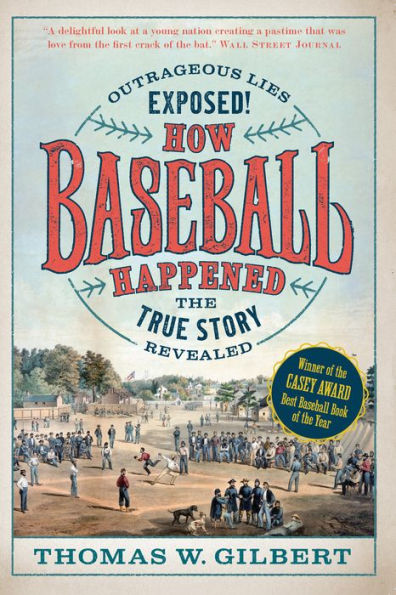To those who care about the past, great institutions may be of most interest when they begin. Why? Because in their sparse fields and green shoots may be seen essential attributes less visible when the endeavor is in full flower. How did photographs come to be, or movies or automobiles or computers? All origins stories fascinate.
In baseball, why nine innings, nine men, and ninety feet? Why a bat and ball and, later, a glove? Why are the bases set in a circle? Indeed, why baseball—as a game, then a sport, then an emblem for the nation in which it was formed if not truly born?
To the fan of today the answers seem so obvious as to require no explanation, yet to historians of the game they have been, until quite recently, enduring mysteries. In the 1840s and 1850s, the reasons for the rise of baseball would have been first, the novelty and excitement of play, an unseemly activity for grown men; second, the opportunity for urbanites to exercise amid fresh air in a sylvan setting; and third, the assertion of a binding national identity, independent of John Bull and his national game of cricket. As America entered the 1860s and was nearly torn asunder, other reasons emerged as to how baseball happened, and why.
About ten years ago, when I was completing my own book on the early game, I was asked at a cocktail party, “What, after all your years of research, remains the great unanswered question in baseball?”
With no forethought and yet not skipping a beat, I offered, “What is it that is so satisfying about a game of catch?”
In my eighth decade I am a bit closer to an answer, I suspect. The simple idea of “to and fro” suffices to explain all that was once complex.
I still follow baseball every day, watching more than a hundred games each season. Baseball may be the one thing that I have cared about unceasingly since I was five. In my earlier work I went forward, advancing analytic notions of how the game might be improved, or at least measured more realistically. I began to wonder about what might really be going on, hidden from sight yet discernible from the game’s statistical residue. More recently I have looked back, to a time a century and more before my birth, to provide a firmer grasp of baseball’s serpentine story and the lies and legends that have attached to it. The pleasure I take in baseball games today is enriched by a knowledge of distant games and long-dead players no less vivid for their seeming invisibility.
I attended my first games at the Polo Grounds and Ebbets Field, and my worship of baseball heroes—first on cardboard, then on television, and at last at the ballpark—began with Duke Snider and Jackie Robinson. Today my favorites—a grownup may not be permitted heroes, right?—are the players and innovators whose stories are fascinating because what they did, they did first: Doc Adams, George Wright, Al Reach, King Kelly … oh, I could go on.
Why baseball? One may approach the question philosophically, socially, culturally, and of course historically. Tom Gilbert looks “not in box scores, in game accounts or in baseball rules changes—and certainly not in baseball’s own ridiculous creation tales—but instead in larger cultural, economic and social trends and in the whole lives and times of the men who played, promoted and wrote about the game.” In his splendidly created necropolis he summons the ghosts of Jim Creighton and Joe Start and other ancient worthies to cavort once more.
When journalists become historians—a path often taken—they retain the useful guidelines of their former craft: who, what, where, when, and how. In their invaluable works, Robert Henderson and David Block addressed the origins of bat and ball games (the where and when) around the world. My own Baseball in the Garden of Eden moved from Europe and Africa to America and addressed the what, i.e, the facts surrounding the game’s beginnings rather what self-anointed fathers of the game wished us to believe. Gilbert addresses how baseball happened and, delightfully, its anagram of who.
For him—and for me; I have been convinced—the game may have been “invented” elsewhere but, like a certain tree, it grew in Brooklyn. People made this game grow, amid a swirl of larger cultural, economic and social trends, and he tells their stories brilliantly.
What had begun as a field sport in the 1830s, a sort of outdoor gymnastics precipitated by an embrace of muscularity and a fear of cyclically recurring cholera, became an enterprise and cultural phenomenon. The need for playing grounds prompted New York baseballists to leave Manhattan for the Elysian Fields of Hoboken, New Jersey. The open land of Brooklyn, a separate city from New York, beckoned, too. Grassy fields were enclosed and flooded, to become rinks for skating, a craze predating the onset of baseball.
By the 1860s shrewd promoters took advantage of the spring thaw to create baseball fields for paid admission. Money came in, simultaneously corrupting and condemning the amateur game and stimulating the professional one that followed. Entrepreneurs, journalists, and gamblers made a buck off it, and many spectators placed their wagers at the game or took part in betting pools. But the outcome that could not have been foreseen was the emergence of a fan base, attached to a particular locality and club simply for the reflected glory of belonging, apart from any pecuniary interest. People would pay simply to watch young men vie for honors.
How Baseball Happened is a brilliant new approach to our game and its author tells a hundred stories you haven’t heard before. It is my honor to invite you to enter into his world.
How is baseball history to be written henceforth? Like this.
John Thorn
Official Historian,
Major League Baseball



